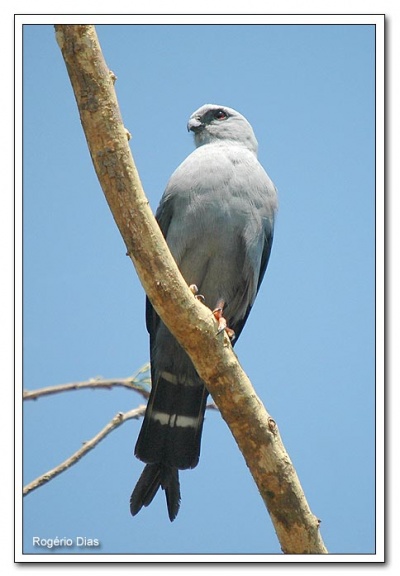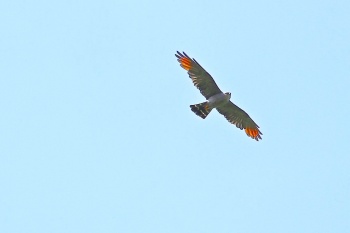(Flight picture. Attempt to disguise copied text. References updated) |
Aloktewari (talk | contribs) (copyright symbol to images) |
||
| (One intermediate revision by one other user not shown) | |||
| Line 1: | Line 1: | ||
| − | [[Image:Plumbeous_Kite.jpg|thumb|400px|right|Photo by '''[http://www.birdforum.net/member.php?u=44584 Rogerio Araújo Dias]''' <br />Luzinia, [[Brazil]]]] | + | [[Image:Plumbeous_Kite.jpg|thumb|400px|right|Photo © by '''[http://www.birdforum.net/member.php?u=44584 Rogerio Araújo Dias]''' <br />Luzinia, [[Brazil]]]] |
;[[:Category:Ictinia|Ictinia]] plumbea | ;[[:Category:Ictinia|Ictinia]] plumbea | ||
==Identification== | ==Identification== | ||
| − | 29–38 cm; Long pointed wings | + | 29–38 cm (11½-15 in); Long pointed wings |
*Slate grey | *Slate grey | ||
*Pale head and underparts | *Pale head and underparts | ||
| Line 16: | Line 16: | ||
'''South America''': ranges from [[Colombia]], [[Venezuela]] and [[Trinidad]] south to [[Bolivia]], southern [[Brazil]] and northern [[Argentina]]. | '''South America''': ranges from [[Colombia]], [[Venezuela]] and [[Trinidad]] south to [[Bolivia]], southern [[Brazil]] and northern [[Argentina]]. | ||
| − | [[Image:Plumbeous Kite1.jpg|thumb|350px|right|Photo by {{user|Stanley+Jones|Stanley Jones}}<br />Reserva Natural Maycu, Zamora-Chinchipe Province, [[Ecuador]], November 2014]] | + | [[Image:Plumbeous Kite1.jpg|thumb|350px|right|Photo © by {{user|Stanley+Jones|Stanley Jones}}<br />Reserva Natural Maycu, Zamora-Chinchipe Province, [[Ecuador]], November 2014]] |
Resident in South America but Central American birds move south for the winter. | Resident in South America but Central American birds move south for the winter. | ||
==Taxonomy== | ==Taxonomy== | ||
| Line 30: | Line 30: | ||
'''Call''': a whistled ''si-see-oo''. | '''Call''': a whistled ''si-see-oo''. | ||
==References== | ==References== | ||
| − | #{{Ref- | + | #{{Ref-Clements6thAug15}}#Handbook of the Birds of the World Alive (retrieved March 2015) |
#Wikipedia | #Wikipedia | ||
{{ref}} | {{ref}} | ||
==External Links== | ==External Links== | ||
{{GSearch|Ictinia+plumbea}} | {{GSearch|Ictinia+plumbea}} | ||
| − | [[Category:Birds]][[Category:Ictinia]] | + | <br /> |
| + | {{Video|Plumbeous_Kite}} | ||
| + | |||
| + | [[Category:Birds]][[Category:Ictinia]] [[Category:Videos]] | ||
Revision as of 02:53, 27 March 2019
- Ictinia plumbea
Identification
29–38 cm (11½-15 in); Long pointed wings
- Slate grey
- Pale head and underparts
- Black twil with 2-3 white bands
- Rufous inner primary webs
- Red eyes
- Orange legs
Sexes are similar
Jveniles: white-streaked grey upperparts; dark-streaked whitish underparts. They lack the rufous wing patch.
Distribution
Central and South America
Central America: breeds in eastern and southern Mexico from southern Tamaulipas southwards and from Guatemala to Panama.
South America: ranges from Colombia, Venezuela and Trinidad south to Bolivia, southern Brazil and northern Argentina.
Resident in South America but Central American birds move south for the winter.
Taxonomy
This is a monotypic species[1].
Habitat
A variety of lowland forest types are used. They use more open areas on passage.
Behaviour
Breeding
They build a stick nest in a tree. The clutch consists of 1-2 blue-white eggs. The chicks are fed by both adults.
Diet
Their main diet consists of flying insects. These are supplemented occasionally with other small vertebrates and snails.
Vocalisation
Call: a whistled si-see-oo.
References
- Clements, J. F., T. S. Schulenberg, M. J. Iliff, D. Roberson, T. A. Fredericks, B. L. Sullivan, and C. L. Wood. 2015. The eBird/Clements checklist of birds of the world: v2015, with updates to August 2015. Downloaded from http://www.birds.cornell.edu/clementschecklist/download/
- Handbook of the Birds of the World Alive (retrieved March 2015)
- Wikipedia
Recommended Citation
- BirdForum Opus contributors. (2024) Plumbeous Kite. In: BirdForum, the forum for wild birds and birding. Retrieved 20 April 2024 from https://www.birdforum.net/opus/Plumbeous_Kite
External Links





